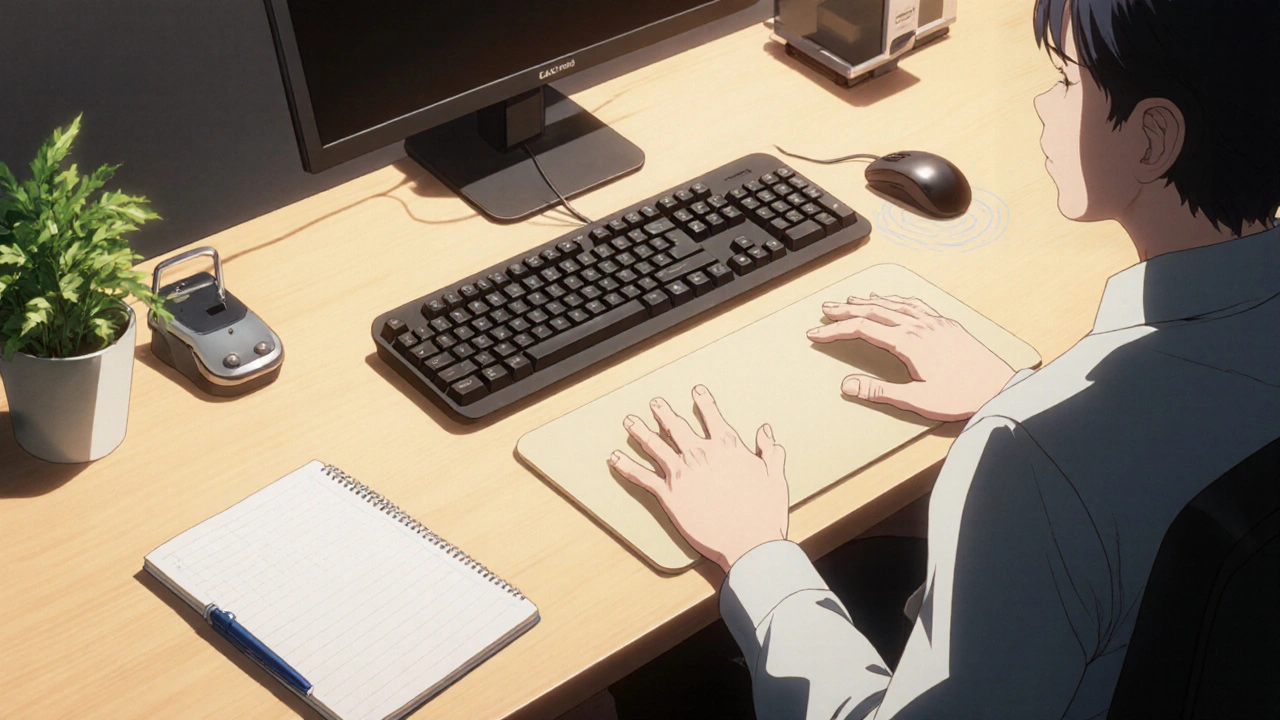Workplace Tremor Impact Calculator
Discover which workplace factors most impact your tremors and get tailored strategies to manage them effectively. Your assessment results will guide your daily management plan.
Ever notice your hands shaking right before a big presentation? You’re not alone. Tremors can turn a routine workday into a challenge, but the good news is that with the right strategies you can keep the shaking under control and stay productive.
What Exactly Is a Tremor?
Tremor is a rhythmic, involuntary movement of a body part, most commonly the hands or arms. It can range from barely noticeable to severe enough to interfere with typing, writing, or handling tools.
Two of the most common medical causes are Essential tremor and Parkinson's disease. While both involve shaking, the underlying mechanisms, triggers, and treatment options differ.
Why Tremors Flare Up at the Office
- Stress and anxiety - Tight deadlines and high‑stakes meetings raise cortisol, which can intensify tremor amplitude. \n
- Screen fatigue - Staring at a monitor for hours strains the eyes and neck, leading to muscle tension that worsens shaking.
- Caffeine overload - A morning espresso may boost alertness, but excess caffeine can act as a stimulant for tremor activity.
- Poor ergonomics - Non‑adjustable chairs, keyboards that are too high, or a desk that forces awkward wrist angles increase muscle strain.
Identifying which of these triggers affect you is the first step toward a calmer workday.
Practical Ways to Reduce Symptoms While Working
- Adjust Your Workstation - An ergonomic workstation can dramatically cut tremor‑inducing tension. Keep your monitor at eye level, use a split keyboard, and position the mouse close to the keyboard to avoid over‑reaching.
- Mindful Breathing - Simple breath‑counting exercises (inhale 4 seconds, hold 2, exhale 6) lower stress hormones within minutes. Practice during short breaks or before a stressful call.
- Stay Hydrated - Dehydration can exacerbate muscle tremors. Aim for 1.5‑2 liters of water daily, and keep a bottle at your desk.
- Limit Caffeine - Swap one of your daily coffees for decaf or a low‑caffeine tea. The reduction in stimulant load often translates to steadier hands.
- Medication Review - If you’re prescribed medication for essential tremor (e.g., propranolol or primidone), coordinate with your doctor to ensure dosage aligns with work‑day demands.
- Physical Therapy - Targeted physical therapy exercises improve muscle control. Simple wrist‑flexor stretches performed three times a day can reduce tremor magnitude.
- Mindfulness Practices - Short guided meditations (5‑10 minutes) before the workday help maintain a calm baseline, which keeps tremor spikes at bay.
- Assistive Devices - Weighted pens, dampening mouse pads, or voice‑to‑text software can offset the impact of shaking when precision is required.

Choosing the Right Assistive Tools
| Device | Primary Benefit | Typical Cost (UK) |
|---|---|---|
| Weighted Pen | Reduces fine‑motor tremor while writing | £12‑£20 |
| Dampening Mouse Pad | Minimizes hand shake during cursor control | £8‑£15 |
| Speech‑to‑Text Software | Eliminates need for typing altogether | £0‑£30/month |
| Wrist Support Brace | Stabilizes wrist angle during prolonged desk work | £10‑£25 |
Investing in one or two of these tools can save hours of frustration and help you maintain a professional appearance.
Talking to Your Employer About Accommodations
Most workplaces are required by law to provide reasonable adjustments for health conditions. Here’s a concise plan for the conversation:
- Gather documentation - A note from your GP outlining the condition and suggested accommodations helps legitimize the request.
- Identify specific needs - Whether it’s a sit‑stand desk, a quieter workstation, or flexible break times, be clear about what will help.
- Propose a trial period - Offer a 4‑week pilot so both you and management can assess effectiveness.
- Follow‑up - Document any improvements in productivity or symptom control and share the results.
Approaching the discussion with a solution‑oriented mindset makes it easier for managers to say yes.
Building a Productive Routine When You Have Tremors
- Chunk Your Tasks - Break larger projects into 15‑minute blocks. Short bursts reduce fatigue and keep tremors from building up.
- Schedule “Steady Periods” - Identify times of day when tremors are naturally milder (often mid‑morning after caffeine has worn off) and tackle high‑precision work then.
- Use the Pomodoro Technique - 25 minutes of focused work followed by a 5‑minute rest helps manage stress and keeps muscles relaxed.
- Prepare a “Backup” Toolkit - Keep a spare stylus, a second mouse, or a pre‑filled template on hand so you can switch quickly if shaking spikes.
Consistency is key. The more you shape your day around your body’s rhythm, the less you’ll feel limited by tremors.
Quick Checklist for Daily Management
- ☑ Review caffeine intake and replace one drink with water.
- ☑ Perform wrist stretches before logging onto the computer.
- ☑ Adjust chair height and monitor angle for ergonomic alignment.
- ☑ Keep assistive device(s) within arm’s reach.
- ☑ Take a 2‑minute mindful breathing break every hour.
- ☑ Log any symptom spikes and note possible triggers.
Ticking these boxes each day builds a habit that protects both your health and your performance.
Key Takeaways
tremors at work don’t have to derail your career. By understanding the cause, tweaking your environment, using the right tools, and communicating effectively with your employer, you can keep shaking under control and stay productive.
Can essential tremor be cured?
There is no cure, but symptoms can be managed with medication, lifestyle changes, and assistive devices. Most people find a combination that reduces shaking enough for daily activities.
How do I explain my tremor to my manager?
Prepare a brief note from your doctor, list specific accommodations you need (e.g., ergonomic desk, extra breaks), and suggest a short trial period. Focus on how the adjustments improve productivity.
Are there apps that help with tremor management?
Yes. Apps like Calm or Headspace guide mindfulness sessions, while speech‑to‑text tools such as Dragon NaturallySpeaking reduce the need for typing. Some apps also track symptom logs for medical appointments.
What foods should I avoid to keep tremors low?
Limit caffeine, sugary drinks, and excess alcohol. A balanced diet rich in magnesium (nuts, leafy greens) and omega‑3 fatty acids (fish, flaxseed) supports nerve health.
Is it okay to take breaks whenever tremors worsen?
Absolutely. Short, frequent breaks prevent fatigue and give your muscles a chance to reset. Pair breaks with deep‑breathing or light stretching for the best effect.


Comments (14)
Jay Kay October 19 2025
Hands shaking? That’s just your brain screaming for a break!
Penny Reeves October 24 2025
Fundamentally, the neurophysiological cascade behind tremors is exquisitely documented in peer‑reviewed literature, and the recommendations you listed are merely the tip of an iceberg of evidence‑based interventions. While ergonomic adjustments are commendable, the omission of neurofeedback protocols and adaptive neurostimulation betrays a superficial grasp of the subject. Moreover, the reliance on weighted pens ignores the nuanced efficacy data favoring proprioceptive training regimes. In short, a more scholarly synthesis would incorporate longitudinal clinical trials and meta‑analytical insights. Consider revisiting the primary sources for a truly comprehensive guide.
Sunil Yathakula October 29 2025
Yo bro, i totally get the hand shake vibe during those big calls – it’s like your body’s on turbo mode and the brain can’t find the chill button. try doing a quick “5‑5‑5” breath thingy (inhale 5, hold 5, exhale 5) right before you hop on the Zoom, it’s low‑effort and actually helps calm the nerves. also, keep a water bottle at your desk and sip often; dehydration makes the tremor louder. you’ve got this, just give your muscles a little love and the shakes will back off.
Catherine Viola November 2 2025
It is imperative to recognize that the ostensibly benign ergonomic recommendations may, in fact, be a component of a broader agenda to normalize physiological variance while obfuscating corporate liability. The subtle pressure exerted by management to accept minimal accommodations without thorough occupational health oversight raises substantive concerns regarding the integrity of workplace welfare protocols. Consequently, one must remain vigilant and request comprehensive, independently verified assessments rather than acquiescing to piecemeal adjustments.
sravya rudraraju November 7 2025
The prevalence of essential tremor among the working population, while often underreported, warrants a systematic approach that integrates both physiological and psychosocial dimensions.
First, an individualized assessment should be conducted by a qualified neurologist to delineate the specific tremor phenotype and its underlying etiological factors.
Following diagnosis, the implementation of an ergonomically optimized workstation serves as the cornerstone of mitigating motoric disturbances, with precise adjustments to chair height, monitor angle, and input device placement.
Second, regular participation in targeted physiotherapy sessions can foster neuromuscular coordination, thereby attenuating tremor amplitude over time.
Third, the incorporation of evidence‑based mindfulness practices, such as diaphragmatic breathing and guided meditation, has demonstrably reduced cortisol levels, which directly correlate with tremor severity.
Fourth, nutritional optimization, including adequate hydration and a diet rich in magnesium and omega‑3 fatty acids, supports neuronal function and may contribute to symptom amelioration.
Fifth, judicious modulation of caffeine intake, substituting high‑dose espresso with modestly caffeinated alternatives, prevents pharmacological amplification of tremor activity.
Sixth, the strategic use of assistive technologies, ranging from weighted pens to speech‑to‑text software, empowers individuals to maintain productivity without compromising quality.
Seventh, transparent communication with employers, grounded in documented medical recommendations, facilitates the negotiation of reasonable accommodations under prevailing labor statutes.
Eighth, the establishment of a structured work‑break schedule, employing techniques such as the Pomodoro method, promotes periodic muscle relaxation and prevents fatigue‑induced tremor exacerbation.
Ninth, ongoing self‑monitoring through a symptom log enables the identification of situational triggers and the adjustment of intervention strategies accordingly.
Tenth, fostering a supportive peer network within the workplace can alleviate the psychosocial stressors that often precipitate tremor spikes.
Eleventh, periodic re‑evaluation of pharmacological regimens in collaboration with the prescribing physician ensures optimal dosing that aligns with occupational demands.
Collectively, these multimodal interventions constitute a comprehensive framework that not only diminishes tremor manifestations but also enhances overall occupational well‑being.
In sum, by embracing a proactive, interdisciplinary approach, individuals can regain confidence, uphold professional standards, and thrive in their respective roles despite the presence of tremor.
Ben Bathgate November 11 2025
Look, all that fancy talk sounds good on paper, but most of us don’t have time to log every symptom and schedule physio sessions between meetings. If the weighted pen actually stops the shake, just buy it and move on – the rest is fluff.
Kevin Sheehan November 16 2025
In the grand tapestry of work life, tremors are merely a reminder that our bodies are not separate from the mental narratives we construct; embracing that tension as a catalyst rather than a constraint can transform the very act of typing into a meditation on impermanence.
Jameson The Owl November 21 2025
There is a covert agenda being pushed by corporate wellness programs that aims to normalize neurological quirks while extracting increased labor output from unsuspecting employees. The prescribed solutions-weighted implements, ergonomic chairs, mindfulness apps-serve to placate dissent and keep the workforce in a state of compliant compliance. By accepting these measures without scrutiny you inadvertently endorse a system that profits from the hidden costs of untreated tremor conditions. Question the narrative and demand transparent, evidence‑based accommodations beyond corporate‑generated soundbites.
Ankitpgujjar Poswal November 25 2025
Listen up, you don’t need to buy into the corporate script – take control, set up your own protocol, and prove the results with data; that’s the only way to shut down the noise.
Nicole Boyle November 30 2025
From a UX standpoint, the kinetic instability introduced by tremor can degrade input fidelity, leading to increased error rates and reduced task throughput. Leveraging haptic feedback loops and adaptive UI scaling can mitigate these friction points, especially when paired with context‑aware assistive overlays.
Felix Chan December 5 2025
Great point – tech can definitely level the playing field!
Thokchom Imosana December 9 2025
The so‑called “medical consensus” on essential tremor is a construct manufactured by a coalition of pharmaceutical lobbies and academic institutions seeking to perpetuate a cycle of dependency. Historical analyses reveal that tremor‑related research funding spikes precisely when novel drug patents approach expiration, suggesting a profit‑driven motive rather than altruistic scientific inquiry. Moreover, the dissemination of standardized ergonomic guidelines coincides with the rise of corporate insurance policies designed to shift liability away from employers onto the individual worker. As a result, the narrative that simple lifestyle tweaks can fully abate symptoms serves to marginalize those who might otherwise demand systemic reform. It is incumbent upon the discerning worker to scrutinize the provenance of these recommendations and to advocate for open‑source, peer‑verified interventions untethered from commercial interests.
ashanti barrett December 14 2025
Your analysis hits the nail on the head; the intersection of profit and health policy often obscures truly independent solutions, and it’s essential that we collectively push for transparency.
DHARMENDER BHATHAVAR December 19 2025
A systematic approach combining ergonomic optimization, regulated caffeine consumption, and scheduled mindfulness breaks constitutes an evidence‑based strategy for managing workplace tremors.